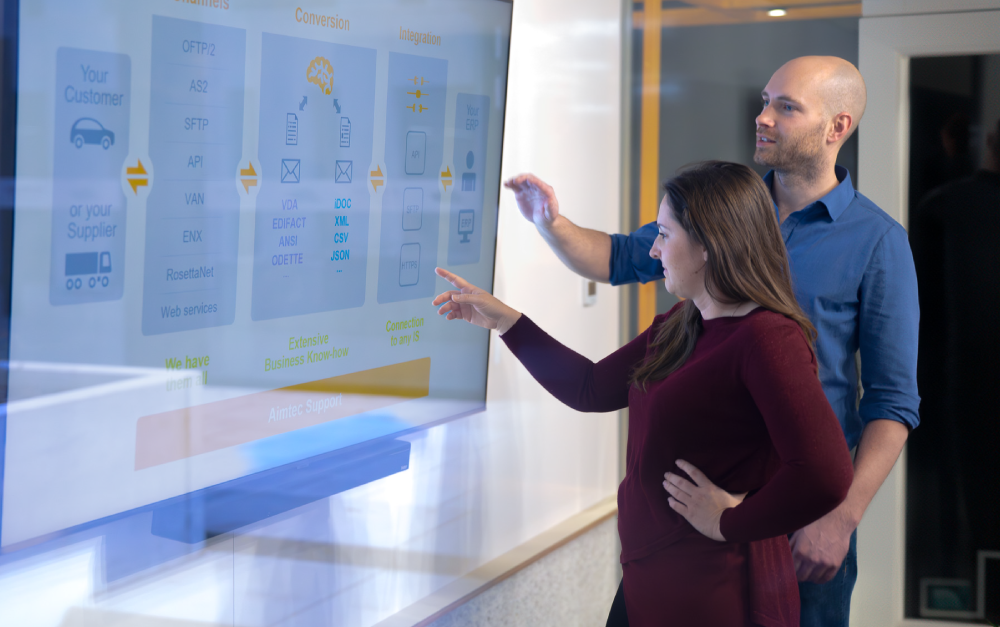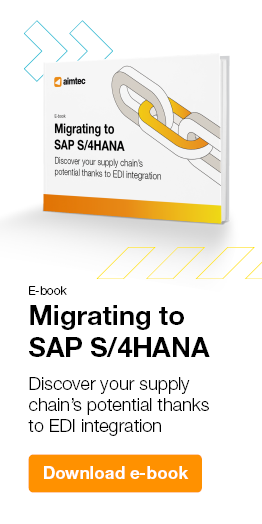EDI ‑ A Communication Standard in the Automotive Industry
- Automotive
- Article
There is currently no alternative for the exchange of information between suppliers and their customers in the automotive industry. EDI (Electronic Data Interchange) has become an industry standard over the past decades and has outgrown its original purpose. Those who want to succeed in the automotive segment cannot do so without solutions and tools designed for this type of communication. In the following lines, we will outline where EDI can be used, introduce the terminology and show what types of messages, communication protocols and communication standards are used in EDI.
EDI’s origins can be found in military logistics, specifically in post-war Berlin, divided into four sectors. The complexity of air transport to Berlin in 1948 required the development of concepts and methods for exchanging large amounts of data on the goods being transported. Based on these early methods, the first TDCC standards were later developed in the United States and continued to be used primarily in transportation. Among the first integrated systems to use EDI were real-time cargo inspection systems. One of them was the London Airport Cargo EDP Scheme (LACES) at Heathrow Airport in London, launched in 1971.
An Indispensable Tool
Since then, EDI has undergone an incredible evolution and, despite repeated predictions that this type of communication exchange would not last and would disappear, it has shown extraordinary vitality.
However, in addition to classic EDI in the form of VDA/EDIFACT files and transmission channels such as OFTP2 and others, newer technologies are also coming to the fore. The world of B2B integration is increasingly using https transfers, API queries, and XML or JSON message formats.
EDI is no longer just electronic data interchange. It is a tool for customer and supply chain integration. From a simple electronic document interchange, it has become a tool for increasing efficiency and productivity through more accurate information for warehousing, production and purchasing.
As the supply chain becomes ever more tightly integrated and the pressure for transparency and visibility increases, EDI is becoming a key element in keeping the production of ever more goods running smoothly. And with more data to be processed as the Internet of Things progresses, it is more than likely that EDI will take on an important, if not the main, role in this area as well. “What started as a necessity in the age of handwritten information has taken over the role of mediating communication between machines,” Stočes explained.
„It’s an indispensable tool for industrial production. This is shown by its proliferation into other industries and the push for adoption at lower levels of the supply chain.“
Jan Stočes, Cloud & Integration Services Director, Aimtec
Basic Terminology
EDI’s remit has swelled considerably over the decades of its development and with the boom in information technology. To get a basic understanding of the terminology, you need to understand the types of messages that customers send to suppliers, the types of messages that go the other way, EDI standards and EDI protocols. The language of the “EDI tribe” looks complicated, but is quite easy to learn.
Types of Messages from Customers to Suppliers
Call-off (LAB, call-off, Forecast)
- It includes multiple delivery dates, a specific date or an outlook for a longer period.
- It does not give a price, it is used as an outlook for production planning and purchasing.
Delivery Schedule Message (FAB, DELJIT)
- It includes a specific delivery date.
- It may also include an exact time.
Order (ORDERS)
- It is used to order specific goods for a specific date and place.
- It may contain multiple products/materials and also a price.
- supplementary messages: ORDCHG, ORDRSP...)
Self-billing Invoice
- It is usually intended for larger companies.
- The customer issues an invoice for its company and sends it to the supplier.
Types of Messages from Suppliers to Customers
ORDER RESPONSE (ORDRSP)
- It serves as an order confirmation.
- It is rarely used in the automotive industry.
Delivery Note (ASN)
- It contains a list of products/materials to be delivered.
- It has details including the quantity, packaging and type of transport.
- It contains the exact date of delivery.
Invoice
- A classic invoice from a supplier to a customer.
Additional messages
-
JIS Call off, Enhanced invoice, Inventory report, Confirmations, Avis, ENGDAT...
EDI Standards
EDI standards are summaries of the rules according to which data in messages are structured.
UN/EDIFACT (United Nations Electronic Data Interchange for Administration, Commerce and Transport)
It is a widely used standard across industries. The individual parts of EDIFACT are divided into folders, such as D.97A. The documentation and reports are updated twice a year, always on 1 April and 1 October. Given how complex EDIFACT has become, subsets specific for individual fields have emerged over time. The message names are always six characters long, typical examples being DELFOR, DESADV, ORDERS, INVOIC and IFTMIN.
VDA (Verband der Automobilindustrie)
The German automotive industry association VDA was one of the first organisations to advocate complete data transfer between car manufacturers and their suppliers. It is, among other things, one of the founding members of ENX and Odette. In the 1970s, the VDA began to define EDI message standards, especially for the automotive industry and its suppliers. The first message (VDA4905) dates back to 1978, but is still in use today. Virtually the whole of the European part of EDI was built on the VDA standard, but it is now being displaced by the more widespread EDIFACT. One of Odette’s “products” is standardised labels on packaging, containing information in both readable form and barcode.
RosettaNet
The not-for-profit consortium is composed of more than 600 companies, mostly from the IT, electrical engineering, semiconductor, telecommunications and service industries. It aims at standardised transmission of electronic messages. RosettaNet is mostly used in the US and Asia; it is in the background in Europe due to EDIFACT. RosettaNet builds on open XML standards and covers all available processes. Messages are divided into individual Clusters (0-7) and then into additional parts. Typical message designations are 3A4, 4A5 or 3A7. However, it is not only a message standard, but also a process standard, because it defines, for example, logical processes between messages or times, with indications of when what response should come for which message, etc.
ANSI ASC X12 (American National Standards Institiute Accredited Standards Committee X12)
This standard is widespread especially in the USA, the first X12 dates from 1982. It has also developed several subsets over time that are specific to industries (X12C - Communications & Controls, X12F Finance, X12M Supply Chain). The difference between EDIFACT and X12 is mainly in the different structure of EDI messages. However, it is typical for both standards that they can be processed via conversion in virtually any format on both communicating sides.
EDI Communication Protocols
Or the channels through which messages are sent. In Europe, OFTP/2 is the most common, in Asia it is AS2 and in America X.400 (VAN). However, WebServices are coming to the fore.
OFTP/2 (Odette File Transfer Protocol)
The OFTP protocol was developed in 1986 in Europe specifically for the automotive industry. In 2007, OFTP/2 was created and allows data to be received and sent data over the Internet. It also addresses communication security by encrypting data or authenticating partners.
AS2. AS3, AS4 (Applicability Statement)
The AS2 protocol was developed by the Internet Engineering Task Force (IETF) specifically to improve data security compared to other protocols in use until that time. As a result, every message goes out via AS2 digitally signed and encrypted. The protocol was used more after Walmart began requiring it. It is now more widely used in the USA and Asia and has spread to other industries, including automotive.
X.400 (pomocí VAN – Value Added Network)
X.400 is an e-mail system used primarily in America for data interchange. Its first version was created in 1984 and, excluding Europe, it has since spread to other areas, such as the military and aviation. VAN takes care of other services besides the message transmission itself, such as guaranteeing the delivery of undistorted information.
SFTP (Secure File Transfer Protocol)
SFTP is a secure protocol for communication on the Internet, developed by the Internet Engineering Task Force (IETF). The reason for its creation was again the emphasis on the security of data sent. The data are encrypted during transmission and only decrypted again at the destination.
ENX
ENX is a communication protocol created by the ENX association. The main founders were German and French automakers who wanted to reduce costs and simplify the electronic interchange of data in the automotive industry. The current fifteen members include major market players such as Audi, BMW, Bosch, Continental, Daimler, DGA, Ford, Renault and Volkswagen. Since 2010, ENX has been unified with the American ANX protocol, guaranteeing cooperation between the European and North American markets.
HTTPS (Hypertext Transfer Protocol Secured)
The HTTPS protocol is used for data transfer using web services and guarantees its security.
Other Features
ASN validation
Digitisation of Invoices
From paper/pdf to an ERP system.
National invoice clearance
WebEDI
Alternative for suppliers without EDI
JIT
Service for processing call-offs, preparing deliveries, printing labels and shipping documents, and generating ASNs.
MFT
Managed File Transfer refers to a technology that provides secure data transfer in an efficient and reliable manner. MFT software is offered to companies as a more secure alternative to using unsecured protocols such as FTP and HTTP, and is also more reliable than the secure SFTP protocol. It enables both internal and external interchange of various types of data, including sensitive and high-volume data. There is also no obligation to pay high SLA fees associated with low FTP performance. Clients can choose both on-premise and SaaS solutions.
ADAC API
ADAC publishes information on the towing needs of vehicles throughout Germany via its API interface. The companies providing these services then bid to cover such requirements through this service. Aimtec's EDI solution supports direct connection to the ADAC API.
PEPPOL
Peppol is a set of specifications for the establishment and primary implementation of an e-procurement system that can be used in different jurisdictions. Through this tool, participating organisations can provide each other with the necessary documentation, including electronic invoices, in machine-readable formats. This network facilitates cross-border procurement and keeps a central directory of participants. The network is regulated by Open Peppol and its contractual partners.
Which way to EDI? We'll be your guide.
Do you dream about error-free and effective communication with your customers and suppliers? We can help you.
>> Schedule a non-binding consultation with our expert.

Marek Šabatka
Share article
Top stories from logistics, production and IT.
Subscribe to Aimtec Insights
By registering, you agree to the processing of your personal data by Aimtec as described in the Privacy policy.
Get top stories and articles
from Logistics, Production and IT.
Subscribe to Aimtec Insights
By registering, you agree to the processing of your personal data by Aimtec as described in the Privacy policy.









